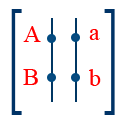Principles of Inheritance and Variation
Linkage and crossing over,mutations
- Bateson and punnett discovered linkage in Lathyrus odoratus (sweet pea) and stated that certain genes stay together due to their location of same chromosome
- Sex linkage is discovered by Morgan in drosophila
- Linked genes do not show independent assortment
- Males don’t show much crossing over [male drosophila, crossing over is absent]
- Strength of the linkage ∝ 1/distance between the genes ∝ 1/crossing over.
- Temperature and X rays induce crossing over
- % combination of genes = % crossing over.
- Complete and Incomplete linkage are the two types of linkages wherein complete linkage, there is no crossing over, whereas in incomplete linkage, non parental combinations occur in meiotic products because of crossing over.
- If all the dominant genes are located in a single chromatid and all recessive genes located in other pair of chromatid, then the condition is called coupling state (or) cis arrangement

- If a single chromatid contains both dominant and recessive alleles, then the arrangement is called repulsion (or) trans type.

-
Mutation [New sudden Inheritable Discontinuous Variation]
- First discovered in Oenothera lamarckiana by Hugo de vries, was later was studied by Morgan in Drosophila
- Somatic mutation (will not pass to offspring) and Germinal mutation (Passes to offsprings) are its two types.
- Exception in somatic mutation is vegetative propagation and asexual reproduction where mutation is passed onto the next generation.
- Depending on the Cause, mutation is of 2 types (i)- chromosomal mutation (ii) Gene mutation
- Chromosomal mutation is of 2 types – (i) Polyploidy (ii) Aneuploidy mutation, under genomic mutation.
- Polyploidy is the increase in the number of set of chromosomes Eg. Autopolyploidy, Allopolyploidy [Triticale]
- Hyperploidy [Trisomy (2n + 1), Tetrasomy (2n + 2)] and Hypoploidy → monosomy (2n – 1), nullisomy (2n – 2) are types of Aneuploidy
- Change in chromosome structure is called chromosomal aberration, which is of 2 types

- Gene mutation is of following types.
→ Point mutation and gross mutation [change in IBP / change in more than IBP resp.]
→ Substitution is of 2 types Transition and Transversion.
→ Transition is when purine and pyrimidines are replaced by another purine and pyrmidine respectively.
→ If a purine is replaced by pyrimidine and vice versa, it is trans version. - Frame shift mutation (most dangerous) is the insertion (or) deletion of 1 or 2 BP. Eg. Muscular dystrophy, Thalassemia etc.
- The mutation by which stop codons are formed is called Non – Sense – mutation.
- Substances causing mutation are mutagens – (i) Physical (ii) Chemical.
- Radiation, Temperature (Q10 = 5) are physical mutagens.
- Nitrous acid, DDT, Mustard gas, LSD are chemical mutagens
- UV rays do not react with Thymine, whereas they act on Adenine to convert hypoxanthine, Guanine to X anthine, Cytosine to Uracil.
- Antibiotics like kanamycin and Streptomycin cause mutation in prokaryote. Paromycin acts on Eukaryotes and causes mutation.
Part-1: Watch this video for the topic from 0:14 to 8:33
Part-2: Watch this video for the topic from 0:09 to 6:03
Part-3: Watch this video for the topic from 0:10 to 11:32
Part-4: Watch this video for the topic from 0:09 to 12:33
Part-5: Watch this video for the topic from 0:07 to 14:20
Part-6: Watch this video for the topic from 0:10 to 8:54
Part-7: Watch this video for the topic from 0:11 to 4:51
Part-8: Watch this video for the topic from 0:13 to 8:42
Part-9: Watch this video for the topic from 0:09 to 5:52
Disclaimer: Compete.etutor.co may from time to time provide links to third party Internet sites under their respective fair use policy and it may from time to time provide materials from such third parties on this website. These third party sites and any third party materials are provided for viewers convenience and for non-commercial educational purpose only. Compete does not operate or control in any respect any information, products or services available on these third party sites. Compete.etutor.co makes no representations whatsoever concerning the content of these sites and the fact that compete.etutor.co has provided a link to such sites is NOT an endorsement, authorization, sponsorship, or affiliation by compete.etutor.co with respect to such sites, its services, the products displayed, its owners, or its providers.

